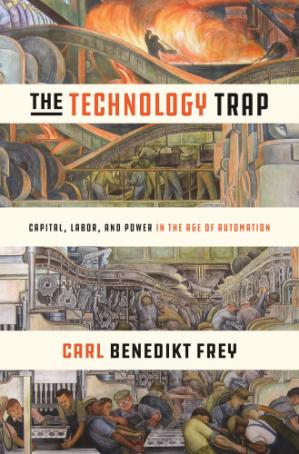The Technology TrapCapital, Labor, and Power in the Age of Automation
|

|
 Diese Seite wurde seit mehr als 8 Monaten inhaltlich nicht mehr aktualisiert.
Unter Umständen ist sie nicht mehr aktuell.
Diese Seite wurde seit mehr als 8 Monaten inhaltlich nicht mehr aktualisiert.
Unter Umständen ist sie nicht mehr aktuell.
 Zusammenfassungen
Zusammenfassungen
 From the Industrial Revolution to the age of artificial intelligence, The Technology Trap takes a sweeping look at the history of technological progress and how it has radically shifted the distribution of economic and political power among society's members. As Carl Benedikt Frey shows, the Industrial Revolution created unprecedented wealth and prosperity over the long run, but the immediate consequences of mechanization were devastating for large swaths of the population. Middle-income jobs withered, wages stagnated, the labor share of income fell, profits surged, and economic inequality skyrocketed. These trends, Frey documents, broadly mirror those in our current age of automation, which began with the Computer Revolution.
From the Industrial Revolution to the age of artificial intelligence, The Technology Trap takes a sweeping look at the history of technological progress and how it has radically shifted the distribution of economic and political power among society's members. As Carl Benedikt Frey shows, the Industrial Revolution created unprecedented wealth and prosperity over the long run, but the immediate consequences of mechanization were devastating for large swaths of the population. Middle-income jobs withered, wages stagnated, the labor share of income fell, profits surged, and economic inequality skyrocketed. These trends, Frey documents, broadly mirror those in our current age of automation, which began with the Computer Revolution.
Just as the Industrial Revolution eventually brought about extraordinary benefits for society, artificial intelligence systems have the potential to do the same. But Frey argues that this depends on how the short term is managed. In the nineteenth century, workers violently expressed their concerns over machines taking their jobs. The Luddite uprisings joined a long wave of machinery riots that swept across Europe and China. Today's despairing middle class has not resorted to physical force, but their frustration has led to rising populism and the increasing fragmentation of society. As middle-class jobs continue to come under pressure, there's no assurance that positive attitudes to technology will persist.
The Industrial Revolution was a defining moment in history, but few grasped ist enormous consequences at the time.The Technology Trapdemonstrates that in the midst of another technological revolution, the lessons of the past can help us to more effectively face the present.
 Dieses Buch erwähnt ...
Dieses Buch erwähnt ...
 Personen KB IB clear | Daron Acemoglu , David Autor , Erik Brynjolfsson , Martin Ford , Bruno S. Frey , Carl Benedikt Frey , Thomas Friedman , David Graeber , John Maynard Keynes , Frank Levy , Karl Marx , Andrew McAfee , Hans Moravec , Richard Murnane , Elon Musk , Peter Norvig , Michael A. Osborne , Michael Polanyi , Derek de Solla Price , Jeremy Rifkin , James A. Robinson , Stuart Russell , Alvin Toffler , Norbert Wiener | ||||||||||||||||||||||||||||||||||||||||||||||||||||||||||||||||||||||||||||||||||||||||||||||||||||||||||||||||||||||||||||||||||||||||||||||||||||||||||||||||||
 Aussagen KB IB clear | Automatisierung fördert Arbeitslosigkeit | ||||||||||||||||||||||||||||||||||||||||||||||||||||||||||||||||||||||||||||||||||||||||||||||||||||||||||||||||||||||||||||||||||||||||||||||||||||||||||||||||||
 Begriffe KB IB clear |  AlphaGo
, Amaras Gesetz
, AlphaGo
, Amaras Gesetz
,  Arbeitslosigkeit Arbeitslosigkeit unemployment
, unemployment
,  China
, China
,  Computer Computer computer
, computer
,  Europa Europa Europe
, Europe
,  Gesellschaft Gesellschaft society
, Industrielle Revolutionindustrial revolution
, society
, Industrielle Revolutionindustrial revolution
,  Künstliche Intelligenz (KI / AI) Künstliche Intelligenz (KI / AI) artificial intelligence
, artificial intelligence
,  Maschine Maschine machine
, machine
,  Produktivität Produktivität productivity
, productivity
,  USA USA
| ||||||||||||||||||||||||||||||||||||||||||||||||||||||||||||||||||||||||||||||||||||||||||||||||||||||||||||||||||||||||||||||||||||||||||||||||||||||||||||||||||
 Bücher |
| ||||||||||||||||||||||||||||||||||||||||||||||||||||||||||||||||||||||||||||||||||||||||||||||||||||||||||||||||||||||||||||||||||||||||||||||||||||||||||||||||||
 Texte |
|
 Tagcloud
Tagcloud
 Zitationsgraph
Zitationsgraph
 Zitationsgraph (Beta-Test mit vis.js)
Zitationsgraph (Beta-Test mit vis.js)
 Zeitleiste
Zeitleiste
 2 Erwähnungen
2 Erwähnungen 
- Power and Progress - Our Thousand-Year Struggle Over Technology and Prosperity (Daron Acemoglu, Simon Johnson) (2023)

- Generative AI and the Future of Work - A Reappraisal (Carl Benedikt Frey, Michael A. Osborne) (2024)


 Volltext dieses Dokuments
Volltext dieses Dokuments
 | The Technology Trap: Gesamtes Buch als Volltext ( : 5496 kByte) : 5496 kByte) |
 | The Technology Trap: Gesamtes Buch als Volltext ( : :  , 7277 kByte) , 7277 kByte) |
 Bibliographisches
Bibliographisches 
 Beat und dieses Buch
Beat und dieses Buch
 Beat hat dieses Buch während seiner Zeit am Institut für Medien und Schule (IMS) ins Biblionetz aufgenommen. Beat besitzt kein physisches, aber ein digitales Exemplar. (das er aber aus Urheberrechtsgründen nicht einfach weitergeben darf). Es gibt bisher nur wenige Objekte im Biblionetz, die dieses Werk zitieren. Beat selbst sagt, er habe dieses Dokument nicht gelesen.
Beat hat dieses Buch während seiner Zeit am Institut für Medien und Schule (IMS) ins Biblionetz aufgenommen. Beat besitzt kein physisches, aber ein digitales Exemplar. (das er aber aus Urheberrechtsgründen nicht einfach weitergeben darf). Es gibt bisher nur wenige Objekte im Biblionetz, die dieses Werk zitieren. Beat selbst sagt, er habe dieses Dokument nicht gelesen.











 Biblionetz-History
Biblionetz-History